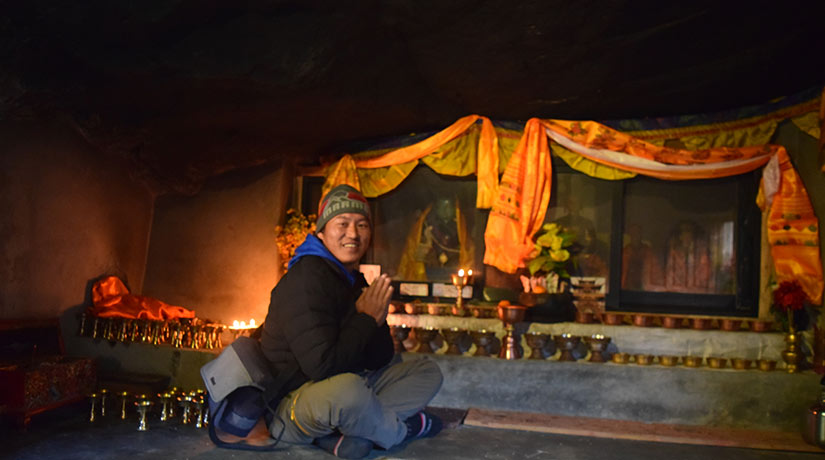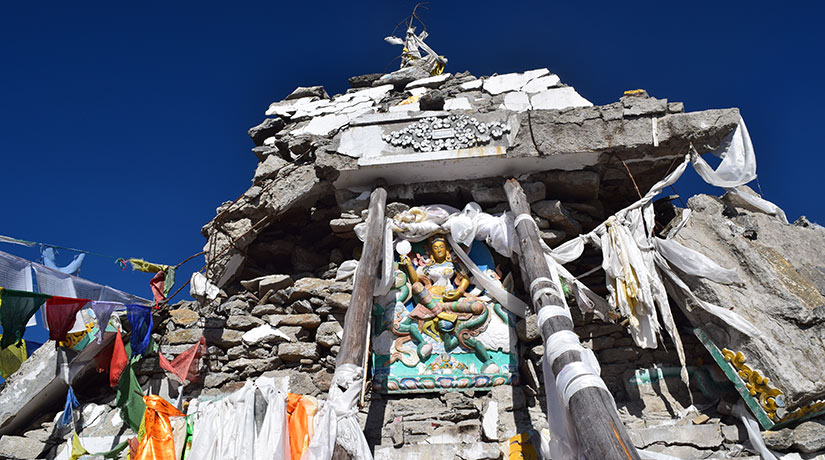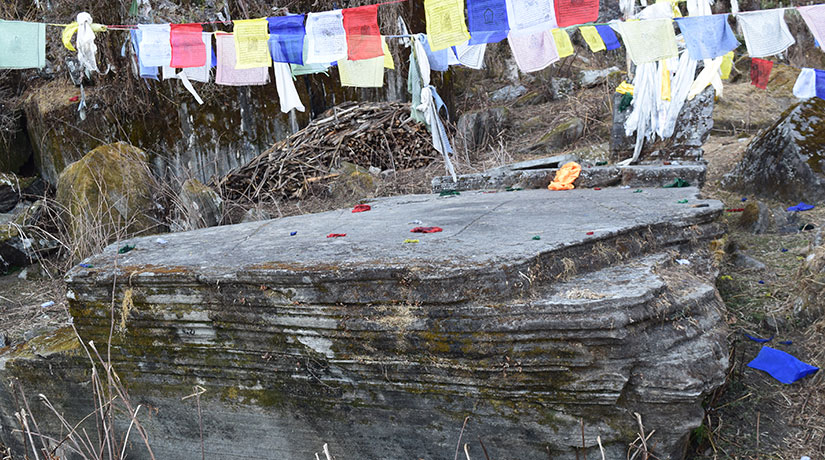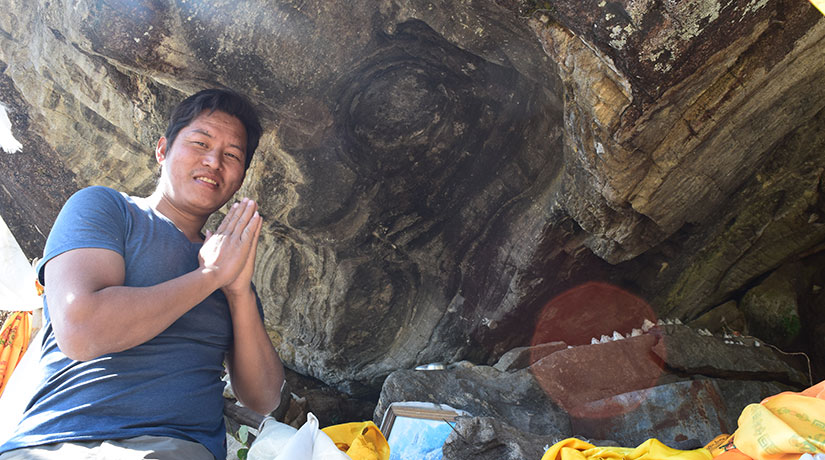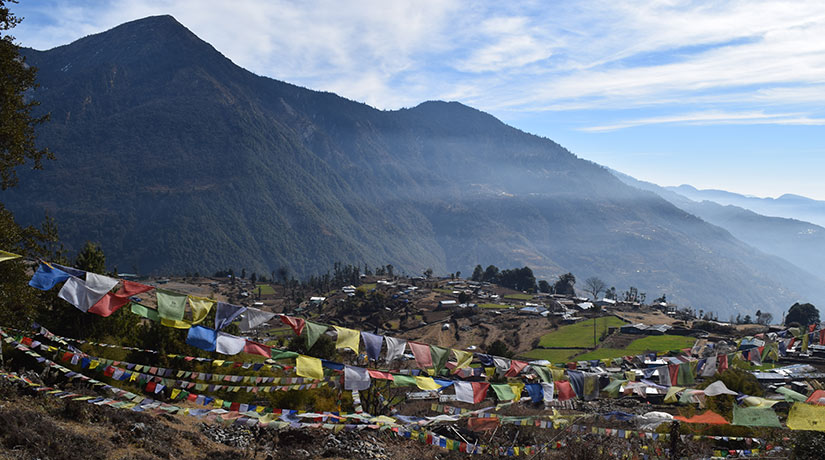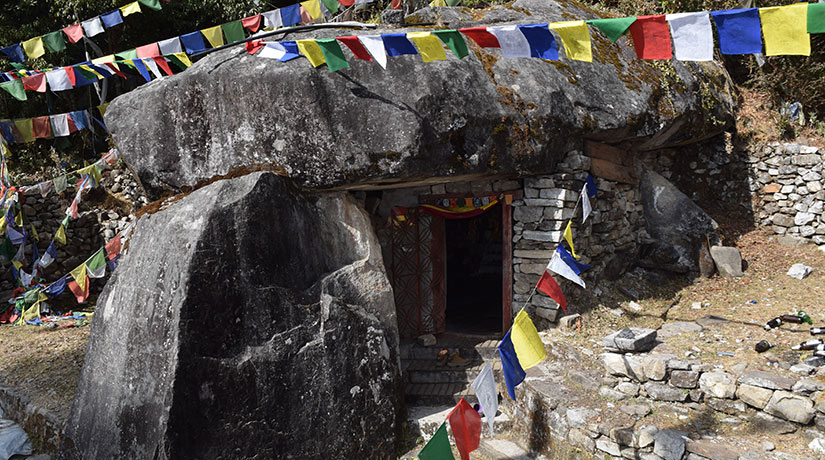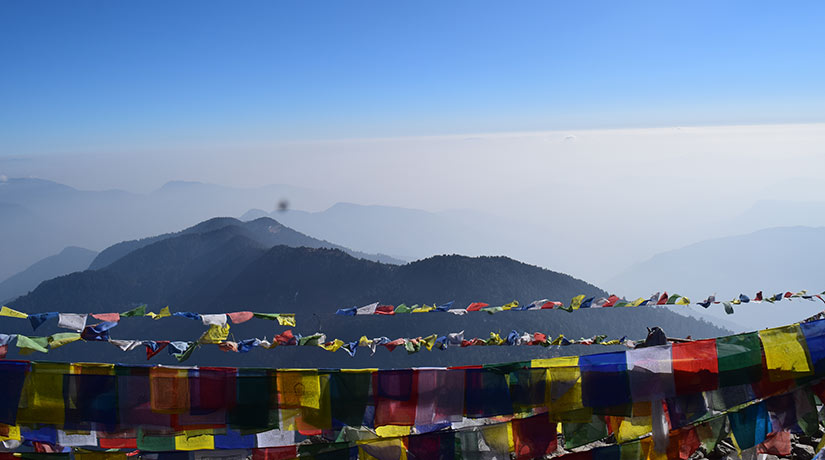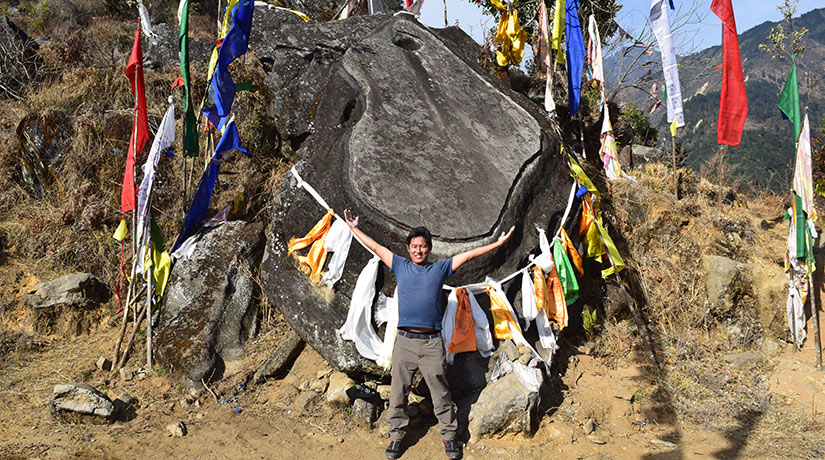Trip Facts
General trp informations1+
Moderate
Teahouse Lodges
3771m
BLD
Public, Private as your Request
Spring and Autumn
Nepal is renowned for its stunning high mountains, deep valleys, brave gorkhas, hardy sherpas, and ancient Buddhist tradition. But the earthquake that shook northeastern Nepal on April 25 had dramatically changed the landscape of many of the mountain region settlements. After 4 years the village of Milamchi-ghyang in Yolmo, a meditation place of Guru Rinpoche and Yeshe Tsogyal is in the normal condition now.
For any devotee of Guru Rinpoche, arriving in Melamchi-gyang is a kind of homecoming. Whether one feels an affinity with the physical landscape – a small mountainside plateau scattered with stone buildings and barley fields, fringed by an ancient and brooding forest, set against the rocky peaks and vivid sky of the Himalayas – or not, the energy infused in this place by the presence and practice of Padmasambava is hard to deny.
Situated in the Yolmo Snow Enclosure, a ‘hidden land’ of the Guru and his chief Tibetan disciple, Yeshe Tsogyal, Melamchi-ghyang is truly a place set apart from the modern world. Only accessible by road these last three years, a road which is even now only motorable four months of the year, this sacred site of Guru Rinpoche is visited more by trekkers than by pilgrims, it being on the Helambu Circuit track. Many who do make it here fail to recognise the great importance and fortune of their having reached this auspicious place.
Yolmo (also known as Helambu), in northern Nepal, is known for its numerous drub-phug, or meditation caves, two of which are famous for being the practice places of Guru Rinpoche. The lower, and more accessible of these is the cave at Melamchi-ghyang. It is known as the Nyin-da Rang-jung Drug-phug, or Meditation Cave of the Self-arisen Sun and Moon, due to the naturally formed shape of a crescent embracing a circle in the stone roof of the cave, symbolizing the union of wisdom and skilful means. Not in the true sense a cave, the structure seems to have been created by a rockfall. A great flat boulder perched upon three smaller boulders in the shape of a triangle, local lamas say it is in keeping with the Guru’s preference to dwell in triangular structures representing the Three Jewels of Buddha, dharma, and sangha. The sides of the cave have been walled up, and the roof has been chiseled out at the rear to create a spacious dwelling place. Some attribute this stonework to the Guru, saying he carved away the rock with his trident, while other sources intimate that the cave was lived in by stone-age people of the Himalayas, long before Padmasambava’s time, who made these renovations to channel dripping water away from their sleeping place.
There is very little known about the exact details of Guru Rinpoche’s tenure in Melamchim-gyang. It is agreed that he was here 1,200 years ago, but it seems that the duration of his stay was never recorded. Although it is speculated that he spent his time here perfecting the practice of the Buddha Amitaba, this is a presumption based only upon his having ordained that a temple to Amitaba be built here at a later time.Khenpo Nyima Dondup standing outside the damaged Meditation Cave of the Self-Arisen Sun and Moon
The cave itself is a warm and inviting space. Home to five 300-year-old statues made of the black clay of Nepal, a family of happy, well fed mice, a couple of cats, and the occasional curious red panda, this sacred place is also open everyday to human visitors and pilgrims. Thanks to the efforts of a local lama and sponsorship from Taiwan, the cave now has a wooden floor and facilities nearby, as well as a more antiquated kitchen attached. One will often find a resident monastic or lay person in open retreat living here, which gives the cave a homely feel and, despite the light flow of pilgrim traffic, a sense that this really is a holy place of Guru Rinpoche.
From the mouth of the main cave a great deal of the Yolmo Valley can be seen, including the great natural pyramid of Ama Yangri (the fourth guardian of the valley) to the east, the mountain retreat centre of Chatral Rinpoche at Neding, and the “snow enclosure” of the Himalayas to the north.
So what’s the value of practicing in such a place? Although it doesn’t bear the same lofty qualifications as the much higher and less accessible Yang-dak Chok meditation cave (having reached which, one will never again be born in the three lower realms), it has been proclaimed by the Guru himself that a day of practice anywhere in the Yolmo Valley is of equal value to a year of practice in mundane locations. And if one is prepared to make the effort to get to Yolmo, Melamchi-ghyang is the ideal place to embark on a practice or meditation retreat.
Only six to nine hours by bus from Kathmandu, or four hours by jeep, Melamchi-ghyang can usually be reached by road from February to May, or by foot any other time, depending on conditions. Pilgrims might want to consider the considerable merit gained by approaching a holy site on foot and take the bus only as far as Kachung, where the great Tibetan yogi Milarepa meditated for three years in the Lion Fort Tiger Cave at the direction of his master, Marpa, and attained realisations. In Kachung one can stay in a local homestay/guesthouse, and, if necessary, hire a porter to help with the trek to Melamchi-ghyang. The last leg of this journey is a three-hour hike from the river valley up to the village above, a picturesque climb on the mountain trail that until only three years ago served as the only way in and out of Melamchi-ghyang. The locals call it a ‘road’, but it is anything but. Sturdy, light shoes or boots and a supply of water are recommended.
Once in Melamchi-ghyang, there are a number of guesthouses to stay in. The local people are Buddhist and speak a dialect of Tibetan, and though most seem to make their living lodging trekkers overnight, they are delighted when Buddhist pilgrims and practitioners come to stay. These people are mountain folk in the truest sense – stocky, solid people of the land, they carry the kukuri or ghorka knife as a matter of practicality, hoick and spit as a custom, and drink a heated home-brew of distilled millet called rakshi, with a dollop of pungent butted melted into it, as an analgesic. Their days are spent cutting wood in the forest, weaving baskets, distilling rakshi, tending crops, herding goats, and preparing food. While it is possible to order meals from the ‘restaurant menus’ provided by these lodges, it is far more sociable and cosy, if one is not on silent retreat, to eat meals with the family, seated on the floor around the woodstove. Meals are most often traditional dhal bhat, with homegrown vegetable, beans, and the famous Yolmo Valley rice.
Another thing Yolmo is famous for is its pristine water quality. Visitors need never be afraid for their health when drinking the water in Melamchi-ghyang – in fact they can rather think of it as a tonic as it possess the eight qualities of ‘pure water’: It has crystal clarity, coolness, sweetness, lightness, and softness, and is soothing to the stomach, free of impurities, and clears the throat. The very soil in this hidden land sparkles, and the rich copper color of its clay puts one in mind of the Copper Colored Mountain upon which Guru Rinpoche is said to reside.
It is said that Guru Rinpoche and Yeshe Tsogyal have left hidden treasures and traces of themselves throughout Yolmo, and nowhere is this more evident than in Melamchim-ghyang. Within an hour’s walk of the Guru’s cave one can find a large number or self-arisen phenomena or pilgrimage sites which are testament to the presence of Padmasambava and Yeshe Tsogyal. Many of these objects and images have arisen in or of a type of stone compounded of tiny quartz crystals (which is beyond this writer’s ability to name) and appear to have been eroded by water or rain, leaving fascinating shapes and patterns, and are mentioned by Chatral Rinpoche in his composition Evocation of the Hidden Valley.
Khandro Sang-phug, The Dakini’s Secret Cave
Only 20 minutes walk from the main cave, on the far side of the school, is evidence that Yeshe Tsogyal herself once stayed in Melamchi-ghyang. This tiny, damp cave situated on the sheer mountainside is said by the locals to be this enlightened princess’s ‘shower’. A trickle of metallic water running from the mouth of the cave is testament to what will be found inside. A metre from the entrance, water drips from the low roof, issuing from what looks remarkably like the genitals of a woman. This dutsi, or nectar, is considered to be a miraculous gift of the dakini herself and held in high regard by Tibetan and Nepali Buddhists.
Jewel Millstone
This artefact of the Guru is a pair of stones, now brightly painted, which was thought to turn spontaneously. It considered to be one of the “great blessings of Yolmo”. The millstone appears to have been originally located in the Amitaba Cave below Melamchi-ghyang, but has been removed to the Amitaba temple in the village to better preserve it. Unfortunately this temple is kept locked and one can only see the millstone when the local lama goes in around 5am in the morning to light the offering lamps.
Old Stupa
The old stupa in the middle of Melamchi-ghyang is built of what remains of one of the early temples built here, which sadly burned down.
Loom
This interesting rock formation located behind the old stupa is said to be the loom of Yeshe Tsogyal. According to local legend, Guru Padmasambava arrived in Milamchi-ghyang wearing nothing but a tiger skin tied around his waist, so Yeshe Tsogyal set about making him an outfit, which she wove using this rock as a loom.
Tsog-shing, Self-Arisen Merit Field
On the eastern edge of Milamchi-ghyang, with a little bit of direction from the locals, one can easily find the self-arisen tsog-shing, or merit field. This large rock structure is said to represent the Kun-zang Dor-sem supplication of Longchenpa and embodies the essence of Samantabhadra, Vajrasattva, Garab Dorje, Śhri Singha, and so forth.
Tab, The Guru’s Kitchen
Down the mountainside to the south of the village, the adventurous pilgrim can find a collection of three large boulders which are said to be the ovens and water fount of Guru Rinpoche. Perhaps it seems a bit of a stretch of the imagination that, A: these rocks are in fact at all representative of a kitchen, and B: that the Guru would need a kitchen a kilometer down the hillside from his cave, but this site has apparently been recognized and verified by Chatrul Rinpoche himself. Like all of these sites and artifacts, these boulders do seem to possess a sort of power.
Shug-tri, The Seat of Guru Rinpoche
Roughly an hour’s walk from the village is the shug-tri, or throne, of Guru Rinpoche. Easily spotted to the north-east, this site is well marked out by prayer flags. The road, however, is not so easy to find, so it’s best to ask the locals. A geographical marvel almost beyond the workings of nature, this great stone dais rides out of the surrounding rocks like the prow of a ship. Surmounted by a throne-like structure, local legend holds that it was here that Padmasambava taught the dharma to dakinis and beings of other realms.
Khang-gyur and Ten-gyur
Directly up the cliff-face from the throne are a series of stones said to be self-arisen representations of the Buddhist scriptures in Tibetan pecha form. This is a bit of a tough climb, and good walking shoes are recommended.
The Nine Yanas
Before arriving at the shug-tri one can find the self-arisen phenomenon of the Nine Yanas, or the nine principle vehicles of Buddhism according to the Nyingma tradition. Like a series of nine Tibetan pecha sitting in a bookshelf, it is obvious why this site is considered holy by locals and learned masters alike.
Head Print
Directly above the main cave is an interesting indentation in the bottom of a rocky overhang considered to be an imprint of the Guru’s head. Strangely unique in this part of the landscape, and perfectly shaped like the top of a head, this really does seem to be a simulacrum. The site is little known and seldom visited. There is no path, and the way is straight uphill through the forest.
Hat Print
Far better known than the head print, the Guru’s hat print is found below the village, not far from the road. It is marked out by prayer flags, but a local guide could be a good idea.
Shoe
This recently discovered image of a giant shoe in the style worn by the Guru has not yet been verified, but certainly seems to be what it claims. Uncovered by the recent excavations for the road, this large stone image lay unnoticed beside the foot trail for generations. Located above the hat print, a walk down from the village could include seeing both sites. Trident Mark: A matter of meters above the image of the shoe is a strange phenomenon – three holes seem to have been melted into boulder in a formation that immediately puts one in mind of a giant trident.
Footprint
Not in Melamchi-ghyang, but visible from the road near Kachung, is a self-arisen phenomenon of another kind – a clearing in the forest high on the western mountainside clearly resembling a giant footprint. According to local people, this clearing has never been forested and will never grow trees.
In sum, Yolmo is an incredible and practically undiscovered practitioner’s paradise of awe-inspiring mountains, faith-inspiring self-arisen phenomena, and health-inspiring waters. Its close proximity to Kathmandu begs that any pilgrim who comes to Nepal make the journey into the mountains to witness for themselves the majesty of the Yolmo Snow Enclosure and receive the blessings imparted by the great Guru of Odiyana and his disciple, Yeshe Tsogyal.
For more information about the area and the history of Yolmo, one can purchase the ‘Guide to the Hidden Land of Yolmo Snow Enclosure and its History’ by Khenpo Nyima Dondrup – ISBN No. 978-9937-506-46-5
Less than a month after the writing of this article a series of earthquakes devastated Kathmandu and the mountain regions of north-eastern Nepal. Melamchi-ghyang was not spared. Formerly a village of 45 homes, only two were left standing after the initial quake struck at 11.56am on April 26. While only one life was lost in the impact, many were injured, and the 300-year-old statues in the rang-jung nyi-da cave are said to have fallen. The temple in the village centre, as well as the renowned village school have collapsed, and with monsoon rains fast approaching, life for the people of Melamchi-ghyang is only going to get harder.
But not all is bleakness and misery. Aid agencies and relief teams, who have been working with the villagers since the early days of the disaster, have already begun to plan how best to rebuild the village, and one U.K.-based charity has even pledged 10 computers to the school.
Now, more than ever, the villagers of Melamchi-ghyang need our support. In the short term they need our donations; in the longer term they need trekkers and Buddhist pilgrims to renew tourism in the region, stay in their new lodges, and visit in their ancient meditation cave.
What's included?
- All meals (Menu Choice) during trek
- Trekkers Information Management System (TIMS) Fees.
- Accommodation in Teahouse Lodges during Trek. (Twin sharing basis or double room)
- A well-experienced English-speaking guide and porters accompany 8 day’s Trek.
- 7 nights accommodation in local lodges sharing twin room on full board according to itinerary. (Breakfast, Lunch, Dinner and Tea/Coffee)
- Ground transfers from Hotels to trek start and end point on private vehicle fares (Can Public Bus if you wish).
- Salary, insurance, food, accommodation of Guide and Crews.
- Loan of duffel Bag.
- 02 night’s accommodation at local 3 star hotel in Kathmandu sharing twin / double room on bed and breakfast basis.
- Trekking map.
- Emergency rescue service arrangements only. Payable from your travel insurance.
- Farewell Dinner
(Note: - 1 porter will carry a maximum weight of 25kgs, 1 porter for every 2 guests and 1 Sherpa will accompany every 5 guests). Includes all meals, accommodation, allowance, insurance of guide and crews & crews equipment
We will provide the best available Local Lodges in the region based on the room availability and cost of room coverage. Please also expect that some of local lodges in higher elevation may not have attached bathrooms here. Hence, clients will have to adjust on common bathrooms as well).
What's not included?
- International airfares.
- Nepal visa fee.
- Travel insurance / Medical evacuation and Helicopter Rescue in case of emergency (Compulsory).
- Personal trekking and Climbing Equipment not mentioned.
- Any Beverages, Bakeries including Machine Coffees, Mineral water, Beers, Alcoholic and Non Alcoholic drinks etc. unless otherwise specified.
- Any items of personal nature such as Telephone bills, Laundry, Bar bills, Showers, Internet & Battery Charge during trekking.
- Services like accommodation, meals & transfers etc. in Kathmandu except listed in inclusion.
- Sightseeing, dinner transfers, entrance fees in Kathmandu.
- Gamow Bags, fleece liner, down jacket, rain poncho etc.
- Meals while staying in Kathmandu.
- Extra nights in Kathmandu and extra days on the trek.
- Extra transfers in Kathmandu except listed in inclusion.
- Extra baggage charges and Extra Porters.
- Tips for Trekking Guide, Porter and driver.
- Any expenses incurred in emergency evacuation/road block due to any reason.
- The prices do not include: undue escalation in fuel prices, new taxes levies on hotels and transportation services or any hikes in entrance fees. Any large tax hikes and new levies shall be payable extra and shall be billed accordingly with prior notice.
International Arrival (1,350m / 4,339ft)
Hotel Welcome Dinner if Included
Welcome to Nepal!
Upon arrival you will be greeted by Bodhi Adventures representative by marigold garland at the Kathmandu airport and transferred to your beautiful hotel. You will meet your local professional qualified leader guide at 5 pm this afternoon and have a full briefing on your Yolmo Hidden Jewl land Trek.
Drive to Timbu (1,580m / 5,183ft) trek to Kharchung (1,805m / 5,921ft) 4 hrs drive / 3 hrs walk
Full Day Teahouse Lodge B, L, D
This day we drive to Timbu (1,580m / 5,183ft) small town by Melamchi khola. We cross small tributary stream of Melamchi khola and we start to climb through terraces. Recently off road is building everywhere so sometime we walk on road and sometime in ancient trail. We pass through small villages. Again we have to cross another old suspension bridge and have to walk through forest about 30 minutes. We get to Kharchung village. If we get on time we visit to TakPhug Senge Milarepa cave.
Overnight in the community homestay Full Board.
Trek to Melamchighyang (2,530m / 8,300ft) 4-5 hrs
Full Day Teahouse Lodge B, L, D
This morning we visit to Milarepa cave, practitioners can stay for meditation about half an hour. We lit butter lamps, we prostrate in the statues. We come back and have breakfast or we can do it on the way to Melamchighyang after breakfast. We walk in the jungle and cross the Melamchi khola and get to other side Pangang, Dukanghang almost left the area by people and we get to Urgen Pesho (2,034m /6,673ft). From here trail is steep up. We visit to Guru Rinpoche shab then we climb to Melamchighyang.
Overnight at Melamchighyang Full Board
Explore Caves and Guru Rinpoche sacred stuffs
Full Day Teahouse Lodge B, L, D
This morning after breakfast first we got the Khandro Phug. Then we come to NiDa Ranjung phug where we do meditation and pooja. Then come to lodge for lunch. After Lunch we visit to Guru Rinpoche Seat, his oven to othersid of the village. Evening we can visit self arisen Monastery just below the village.
Overnight in the Lodge Full Board
Trek to Tarkeghyang (2,600m / 8,530ft)
Full Day Teahouse Lodge B, L, D
Today after breakfast we trek to Tarkeghyang passing Nakote vaillage. Actually from Melamchigyang we have to descend down to Melamchikhola and ascent to Tarkeghyang. We take our lunch in Nakote and climb to Tarkeghyang. If we get early in the evening we visit the famous Chirighyang Monastery just by Tarkegyang.
Overnight in Lodge Full Board
Hike to Neding back to Tarkeghyang (2,600m / 8,530ft)
Full Day Teahouse Lodge B, L, D
This day after having breakfast we set to Neding where Chatral Rinpoche spent 20 years in solitary retreat. We visit Shung Ranjung and Mani Ranjung to, after visiting this places we come back to Tarkeghyang.
Overnight in the Lodge Full Board
Trek to Ama Yang-Ri back to Tarkegyang (2,600m / 8,530ft)
Full Day Teahouse Lodge B, L, D
Today is physically adventurous day to climb Ama Yangri peak (3780 m/ ) high. It’s believed to be the abbot of Ama Yangri, goddess of local protector. We get the mesmerizing Jugal Himalayan range with Shisa pangma, Dorje Lakpa and so on. We descend to Tarkeghyang.
Overnight in the Lodge Full Board
Trek to Shermathang (2,590m / 8,497ft)
Full Day Teahouse Lodge B, L, D
Today after breakfast we leave Tarkeghyang and we go to Sermathang passing through Gangyul. Sermathang is beautiful village with a monastery built by Chatral Rinpoche.
Overnight in the Lodge Full Board
Trek to Mealmchi (870m / 2,554ft) drive back to Kathmandu
Fullday Hotel B,L,D
Today is last and long day trekking but not hard. We walk through beautiful forest and terraces of villages. First we get to a site where Chatral Rinpoche has installed a big impressive Guru Rinpoche statue. Then we walk to Melamchi Bazar. We catch up our jeep and drive back to Kathmandu. Evening Farewell Dinner.
Overnight in Kathmandu Hotel Full Board
Bodhi Adventures wishes to organize another Beyul trek for next time, we say good-bye. We transfer to International airport for your safe return to home country. Tashi Delek/Namaste!
